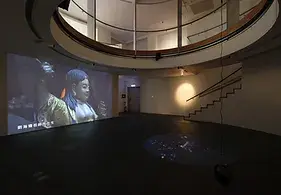高俊宏 Kao JunHonn
《劉海蟾》 Liu Haichan, 2018
關渡美術館個展 kuandu museum of fine arts
單頻彩色有聲影像 Single channel video, color, sound 14'39''
《劉海蟾》是以當今資本土地濫用開墾的新聞事件為啟發,透過 2017 年三峽大豹社傳統土地領域被收購開墾,而興建的一座供奉海蟾法師(劉海蟾)的廟宇,希冀作為求財與聚寶之地。由於興建未經核準,廟宇也在舉報後拆除,而遺留下的偌大山地也反映了當代台灣社會的隱喻,而傳說神話與現實所 交織事件,則成為神性、資本與土地開發結構下的最佳投射。此作品結合神話傳說的敘事,以及重返大豹溪流域的儀式性行動,不僅與藝術家持續進行的“大豹 計劃”並置,更試圖將現今的社會現況與歷史語境做出叠合。
Kao Jun Honn’s latest video work“Taoist Trinity Fairyland”derives from the news events relating to the excessive land disposals and usages cases happened in Taiwan. In 2017, the territory of the aboriginal Taiwanese Topa community in the Sanxia district was acquired and under land clearing for the construction of a Toad Temple, which serves Toad, the local Taoist deity that represents fortune and wealth in traditional belief. The temple was later being reported and demolished due to its unauthorized illegal status. The remaining vast barren mountainous area thus reflects and refers to the current Taiwanese societal condition. The tales of the local deity“Taoist Trinity Fairyland”and the metaphor of the Golden Toad (which symbolizes wealth and luck), therefore, become the utmost epitomes that unravel the complex social structure in which divinity, capitals and the development of the land intertwine. By threading mythical legends, narratives and the ritualistic deeds through the attempt of revisiting the Topa River side, this work not only parallels with artist’s“Topa Project”, also forms correspondences with the contemporaneous social-historical situations.

劉海蟾廟宇濫墾與舉發報導

《劉海蟾》文宣
《劉海蟾》展場







